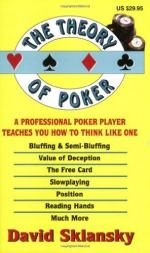|
This section contains 496 words (approx. 2 pages at 400 words per page) |

|
The Theory of Poker Summary & Study Guide Description
The Theory of Poker Summary & Study Guide includes comprehensive information and analysis to help you understand the book. This study guide contains the following sections:
This detailed literature summary also contains Topics for Discussion on The Theory of Poker by David Sklansky.
The Theory of Poker by David Sklansky is a how-to book. It is written for poker players who understand the basics of the games, but need to perfect their knowledge and playing strategies. This book will teach the player to think like a professional. The book will instruct the player about what is and isn't important in poker playing and will help the player to understand the logic that is involved in playing poker games. What should you do in a particular situation? Every poker player wonders about this at times. David Sklansky's book will help the player understand what factors to consider in various situations. The book looks at the theory and concepts involved in games of poker that help the player ascertain what the best play in various game situations is. These theories and concepts are evident in every kind of poker game.
This book does offer rules for the player. It does not teach the player how to play poker. The Theory of Poker is not a book for beginners and will not teach the newbie player the rules of the games. The book teaches the player how to think in the various situations which a poker player will encounter. Sklansky doesn't give the players a list of rules to follow. Memorization is not the way to play poker. He does present the rules of the game in the Appendix for new players, so newbies can benefit from reading the book. But the book is basically intended for those who know the rules and have some experience playing the various games.
This doesn't mean that the new player can't benefit from the book. The new player can learn the rules of the game from the Appendix and then incorporate the rest of the book into the learning process. The new player will learn to think like a pro right away instead of developing bad habits and will learn the correct approaches to different hands and different situations right after learning the rules of the games. This is a book about game theory and how to apply the concepts to poker. Sklansky teaches the player how to view the different situations in terms of game theory and how to determine the best play in the situation.
Since poker is such a popular game now, many people will find this kind of book interesting. It takes a little longer to learn to play the way Sklansky suggests, but it is worth the time. It is better to learn the proper approach instead of just trying to memorize rules.
David Sklansky is considered to be one of the top authorities on poker playing in the world. He has written various books and other documents as well as led seminars for poker players. He has also given seminars at the World Series of Poker. He earns a portion of his income from gambling, so he has to be successful at what he does.
Read more from the Study Guide
|
This section contains 496 words (approx. 2 pages at 400 words per page) |

|



